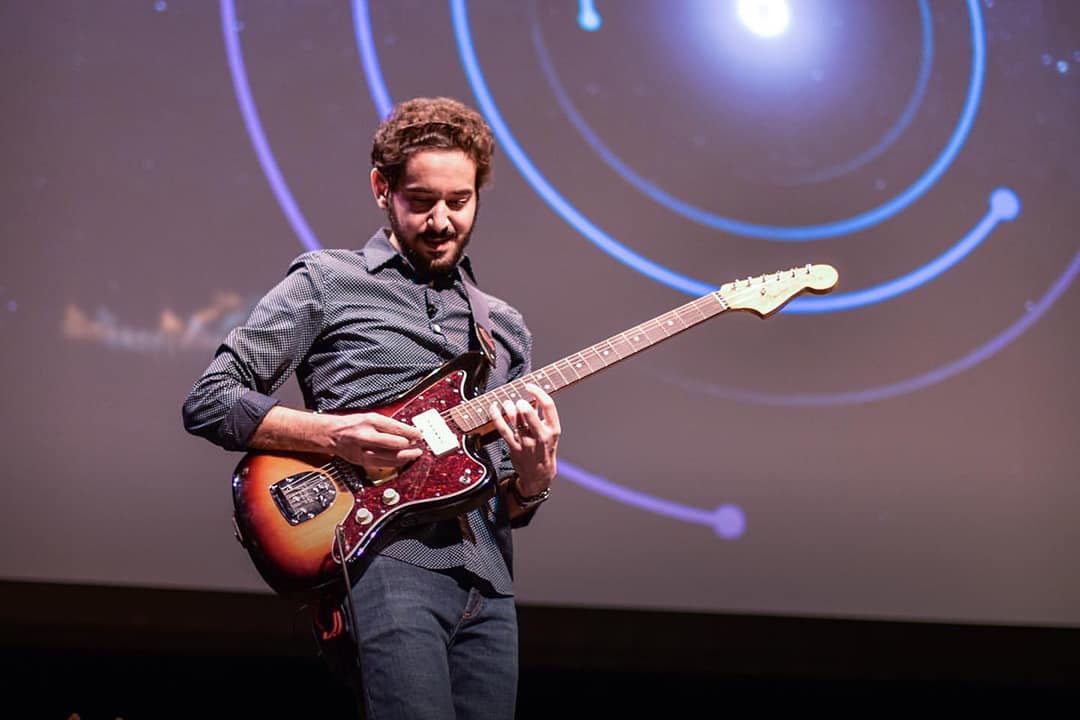Space and music have a long, shared history. Celestial bodies have fueled the inspiration for some of the greatest composers and musicians of the twentieth century, from Gustav Holst to Henryk Górecki, and even David Bowie and Pink Floyd.
In fact, the famed moon landing crew of Apollo 12 listened to Antonín Dvořák’s New World Symphony on their mission. But the connection between music and space runs far deeper. In fact, while we have been composing songs inspired by the universe, the universe itself has been producing music too. We just can’t hear it.
Astrophysicist Matt Russo, a physics lecturer at the University of Toronto, aims to understand the deep connection between music and astronomy. Russo rose to fame when he scaled the orbital frequencies of the seven planets in the TRAPPIST-1 star system into the human hearing range.
In collaboration with Daniel Tamayo, a postdoctoral researcher at UTSC, Russo turned the orbits of the planet in TRAPPIST-1 into notes, producing music from the orbits of the planets he was observing.
Since then, Russo has co-founded SYSTEM Sounds, which he described as a “sci-art outreach project that converts the rhythm and harmony of the cosmos into music and sound.” He also developed a sound-based planetarium show titled “Our Musical Universe” at the Dunlap Institute for Astronomy & Astrophysics’ planetarium, which enabled audience members to view and listen to sights and sounds from celestial bodies.
Bringing music to work
In an email to The Varsity, Russo mentioned that during his PhD and postdoctoral work he studied turbulence in protoplanetary discs. “Some processes that lead to the formation of planetary systems are shrouded in mystery because they occur within a thick disk of dust and gas,” he explained.
Protoplanetary discs are vast rings of gas and dust orbiting a newly formed star. While the structure and evolution of these discs is still relatively unknown, magnetic fields are thought to control the “turbulence” of these disks — the chaotic movement of the gas particles that make up the disc.
“During my PhD and postdoc I worked on a model for how the magnetic field might vary within a disk and studied what that would mean for how long the disk would last and what type of planetary system it could produce,” Russo wrote.
However, Russo had always been interested in both music and physics. “As I was finishing high school, I felt pressure to choose between my two passions of music and astronomy,” he wrote.
“Rather than make a decision I found a way to do both in parallel. While studying music I took astronomy courses on the side and then I played in a band during my astrophysics degree. Throughout this time, I was still struggling to decide because I thought I had to. It wasn’t until the serendipitous discovery of TRAPPIST-1 that the possibility of combining my two passions occurred to me.”
Resonance in music and space
To any musician, the concept of resonance is one taught early on — it is the frequency at which an object vibrates and is used to intensify the volume of a sound. For example, vibrations at the end of a flute pipe cause the air in the flute to vibrate at the same frequency, intensifying the loudness of the sound.
Space, too, follows a similar concept. Orbital resonance occurs when two bodies exert a periodic gravitational pull upon one another. To Russo, the relationship between orbital resonances and musical resonances seemed like little more than idle curiosity until TRAPPIST-1 was discovered.
“The rhythm and harmony of this system was more rich, and even more human, than anything else I’d seen in nature and I had to find a way to make it audible. I first showed it to a class of 5th graders and their response convinced me this was something special that I needed to explore,” Russo wrote.
Latest work on an orchestra of telescopes and science outreach
“Lately I’ve been focused on image sonifications for NASA and the Chandra X-Ray Center,” Russo wrote in his email. His sonification project at Harvard University’s Chandra X-ray Observatory translates data from the centre of the Milky Way galaxy into sound.
The data from this project is from a region of the Milky Way spanning 400 light years across, captured by the Chandra Observatory itself, or the Hubble and Spitzer Space telescopes. Listeners can either listen to ‘solos’ from each telescope, or the sounds from all three can be listened to in an ensemble orchestra of telescopes, in which each telescope plays a different instrument.
“Communicating an image’s multidimensional information as an audio stream is not easy, but it gives people a new perspective and helps those with vision loss experience more of the wonders of astronomy,” Russo wrote.
As part of his new outreach work, Russo launched My Starry Night, a program that lets users see and hear the stars above them at any location, earlier this year. “My Starry Night began as part of a sound-based planetarium show I developed at UofT,” Russo wrote. “At first, creating music videos of the night sky was very time consuming and required several different codes and programs. We spent most of 2019 automating every step so that now it’s as simple as pressing a button.”
The vast expanse of the universe is still largely undiscovered and untraversed. But with work like Russo’s, we are one step closer to uncovering some of the marvels of the galaxy we call home.
— With files from Tahmeed Shafiq


